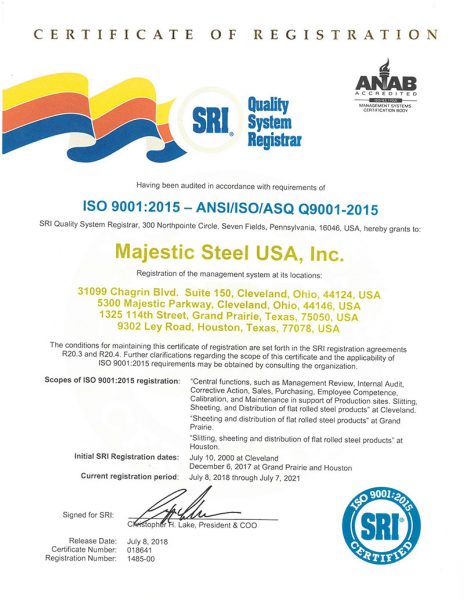cut to length
This is simply taking a coil of steel and cutting it into individual sheets to a particular length that the customer has requested. This is typically done from a standard mill coil width and will maintain a “mill edge” even after processing.
Slitting
Slitting is reducing the width of a standard mill width coil. Coils are placed on the line and unrolled, knives divide the width, and then it is rewound back into a coil. Our order production team provides the best setup to minimize scrap, as multiple slit cuts and customer jobs can be combined to maximize the width of the coil. If a customer requests a width of 29.75”, instead of taking that out of a 36” coil, we instead slit a 60” coil, creating two 29.75” coils (equaling 59.5” total), thus utilizing almost all of the coil.
Blanking
A blanking line takes coils, removes the mill edge on both sides, runs through a slitter head to alter width, and then cuts it into sheets, called blanks. A highly value-adding service, the resulting sheet no longer contains a mill edge, and is now a clean, slit edge sheet. Our blanking line is actually a multi-blanking line, which means the multiple slitter heads can be adjusted to different widths, then cut to a uniform length.
Spinning
Spinning reduces the weight of a standard width coil, or alters the ID (inner diameter) of a coil (from 24” to 20” or vice versa). For example, there is a 20,000 lb. coil in stock, but the customer can only handle or unload a 5,000 lb. max coil. 5,000 lbs. would be unrolled from the larger coil and broken off. Spin downs and ID alterations can be done in one process.
shearing
The shear is performed for sheet quantity or dimension requests too small for our lines. For instance, to process a 12” x 14” sheet request, we would individually shear these, as our cut lines will not hold a 12” slit coil. Generally, sheet requests under 24” utilize the shear, or orders requiring tighter tolerances than our machines can hold.
beading
The process of cutting steel into sheets and adding indentations; typically used for HVAC applications. A bead is a long, drawn-out impression, which is impressed to increase stiffness in metal sheets or plates. Depending on the workpiece size and material thickness, the ratio of length, width and imprint depth must be adjusted to obtain the maximum strengthening effect.
embossing
Stamping process for producing raised or sunken designs or relief in sheet metal. This process can be made by means of matched male and female roller dies, or by passing sheet or a strip of metal between rolls of the desired pattern. Characteristics of the metal embossing process include: its ability to form ductile metals, its use in medium to high production runs, the ability to maintain the same metal thickness before and after embossing, the ability to produce unlimited patterns, depending on the roll dies, and the ability to reproduce product with no variation.
